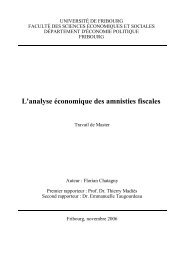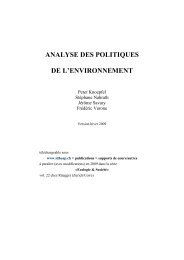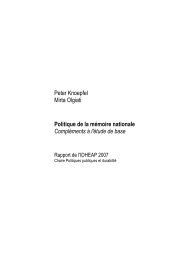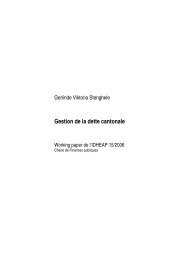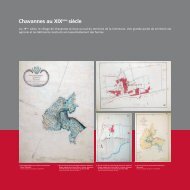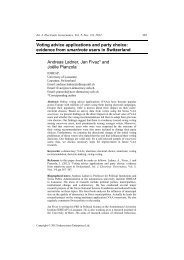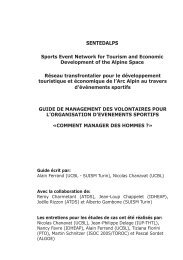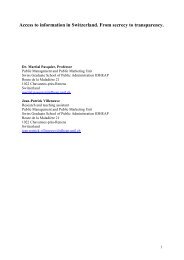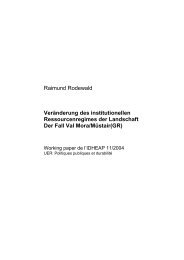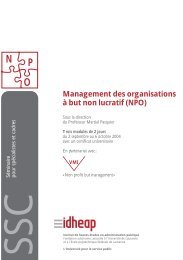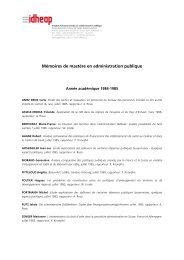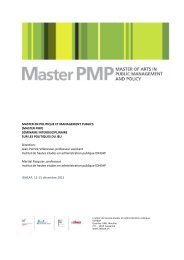Historical Analysis of Institutional Regimes in Switzerland ... - IDHEAP
Historical Analysis of Institutional Regimes in Switzerland ... - IDHEAP
Historical Analysis of Institutional Regimes in Switzerland ... - IDHEAP
You also want an ePaper? Increase the reach of your titles
YUMPU automatically turns print PDFs into web optimized ePapers that Google loves.
23<br />
“forest death”), f<strong>in</strong>ancial support was also provided for the ma<strong>in</strong>tenance and tend<strong>in</strong>g <strong>of</strong> Swiss forests.<br />
This is the motivation beh<strong>in</strong>d the multiplication <strong>of</strong> federal subsidies over the past fifteen years (from<br />
SFr. 60 million <strong>in</strong> 1984 to SFr. 270 million <strong>in</strong> 1990) (Kissl<strong>in</strong>g et al. 1996: 64).<br />
IR type: The forest regime is characterised by the <strong>in</strong>tegration <strong>of</strong> heterogeneous resource uses <strong>in</strong> such<br />
a way that it should be possible to ma<strong>in</strong>ta<strong>in</strong> the capacity <strong>of</strong> the whole resource. Harvest<strong>in</strong>g does not<br />
exceed the susta<strong>in</strong>ed yield (Article 20 WaG). Regulations with regard to different user groups and<br />
products are co-ord<strong>in</strong>ated by the forest law. There is no discrepancy between protection and use<br />
policy, between the regulations for different goods and services <strong>of</strong> forests or between the<br />
prescriptions for different target groups. The new Federal Law on Forests stresses the protective,<br />
social and economic functions <strong>of</strong> forests and the necessity for their co-ord<strong>in</strong>ation. Thus, the forest<br />
regime can be considered as an <strong>in</strong>tegrated IR.<br />
5.2 IR changes and Development Trajectories <strong>in</strong> <strong>Switzerland</strong><br />
It is possible to observe regime changes on the level <strong>of</strong> the regulative system and policy design. The<br />
development trajectories for the five resources differ significantly.<br />
a) Landscape and Air (Policy-driven Trajectories)<br />
The historical development <strong>of</strong> the IRs for the resources landscape and air can only be identified along<br />
the policy design dimension. In reality, there has not been any formal or substantial def<strong>in</strong>ition <strong>of</strong><br />
property or use rights for goods and services <strong>of</strong> both resources. However, the aims for landscape<br />
protection can only be atta<strong>in</strong>ed if exist<strong>in</strong>g and rival use rights are restricted. Thus, <strong>in</strong> both cases, the<br />
development trajectories are clearly policy-driven.<br />
b) Water (Parallel Trajectory)<br />
The historical development <strong>of</strong> the IR for the resource water can best be identified along the policy<br />
design dimension. In reality, there has been little formal change to property and use rights (after the<br />
<strong>in</strong>troduction <strong>of</strong> the Swiss Civil Code <strong>in</strong> 1912) but the substantial content <strong>of</strong> ownership title was<br />
strongly concretised and restricted through use and protection policies.<br />
The first and most important IR change was most certa<strong>in</strong>ly the reorientation <strong>of</strong> the IR from its focus<br />
on water use (from 1916) <strong>in</strong> favour <strong>of</strong> water protection (from 1955). Thus the use <strong>of</strong> water to<br />
generate power was based on the award<strong>in</strong>g <strong>of</strong> water rights, a water rights concession (<strong>in</strong> accordance<br />
with Article 43 WRG), to which, however, there is no automatic right. In this case, the state awards<br />
the concessionary a position which is similar to that <strong>of</strong> the private owner. This clearly excludes third<br />
parties and even replaces the regulative system. In return, the concessionary must pay a so-called<br />
water levy. The opposite situation emerges for water protection (action logic): the property and use<br />
rights (which shall be understood as well-earned rights) were once aga<strong>in</strong> restricted. Accord<strong>in</strong>gly,<br />
unpolluted water should seep to preserve ground water sources, while polluted water must be<br />
treated.<br />
The second and <strong>in</strong>cremental IR change <strong>in</strong>volved the addition <strong>of</strong> quantitative aspects (from 1991:<br />
residual water volumes, volume-based preservation) to the qualitative water protection (from 1955).



